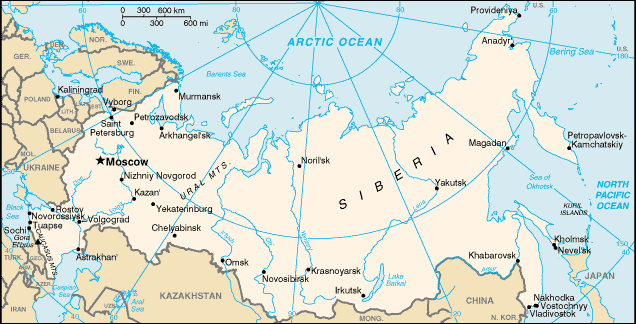
|
Russia
Background:
The defeat of the Russian Empire in World War I led to the seizure of power by
the Communists and the formation of the USSR. The Soviet economy and society
stagnated in the following
decades until General Secretary Mikhail Gorbachev (1985-91) introduced glasnost
(openness) and perestroika (restructuring) in an attempt to modernize
Communism, but his initiatives inadvertently released forces that by December
1991 splintered the USSR into 15 independent republics. S
|

Climate and Terrain:
Climate: Ranges from steppes in the south through humid continental in much of
European Russia; subarctic in Siberia to tundra climate in the polar north;
winters vary from cool along Black Sea coast to frigid in Siberia; summers vary
from warm in the steppes to cool along Arctic coast.
Terrain: broad plain with low hills west of Urals; vast coniferous forest and
tundra in Siberia; uplands and mountains along southern border regions.
Natural resources: Major deposits of oil,
natural gas, coal, and many strategic minerals, timber.
|
|
|
Economy overview:
A decade after the implosion of the Soviet Union in December 1991, Russia is
still struggling to establish a modern market economy and achieve strong
economic growth. In contrast to its trading partners in Central Europe - which
were able to overcome the initial production declines that accompanied the
launch of market reforms within three to five years - Russia saw its economy
contract for five years, as the executive and legislature dithered over the
implementation of many of the basic foundations of a market economy.
|
|